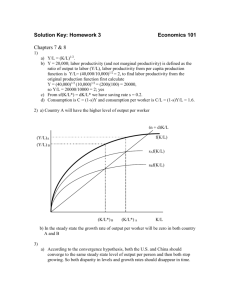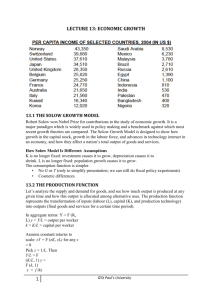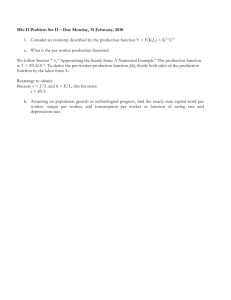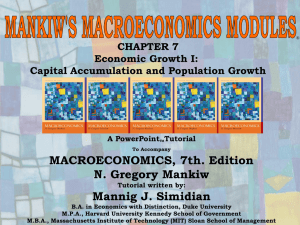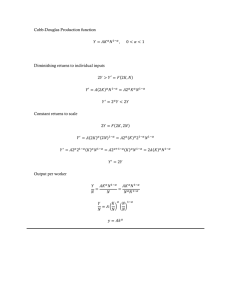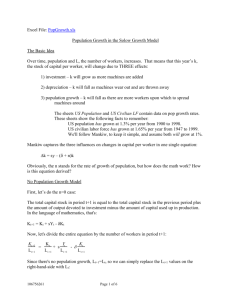Problem Set 5: Economic Growth
advertisement
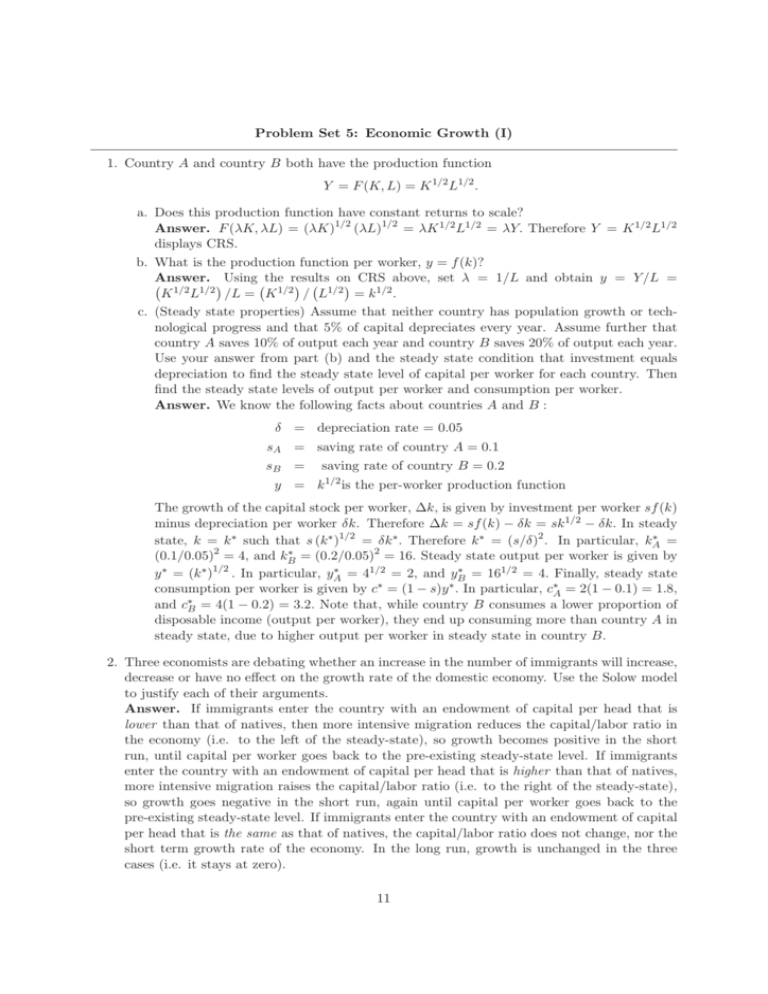
Problem Set 5: Economic Growth (I) 1. Country A and country B both have the production function Y = F (K; L) = K 1=2 L1=2 : a. Does this production function have constant returns to scale? Answer. F (K; L) = (K)1=2 (L)1=2 = K 1=2 L1=2 = Y: Therefore Y = K 1=2 L1=2 displays CRS. b. What is the production function per worker, y = f (k)? on CRS above, set = 1=L and obtain y = Y =L = Using the1=2results 1=2 Answer. 1=2 1=2 =L = K = L = k 1=2 : K L c. (Steady state properties) Assume that neither country has population growth or technological progress and that 5% of capital depreciates every year. Assume further that country A saves 10% of output each year and country B saves 20% of output each year. Use your answer from part (b) and the steady state condition that investment equals depreciation to nd the steady state level of capital per worker for each country. Then nd the steady state levels of output per worker and consumption per worker. Answer. We know the following facts about countries A and B : = depreciation rate = 0.05 sA = saving rate of country A = 0:1 sB = saving rate of country B = 0:2 y = k 1=2 is the per-worker production function The growth of the capital stock per worker, k, is given by investment per worker sf (k) minus depreciation per worker k. Therefore k = sf (k) k = sk 1=2 k: In steady = state, k = k such that s (k )1=2 = k : Therefore k = (s=)2 . In particular, kA 2 2 (0:1=0:05) = 4, and kB = (0:2=0:05) = 16: Steady state output per worker is given by = 41=2 = 2, and y = 161=2 = 4: Finally, steady state y = (k )1=2 : In particular, yA B consumption per worker is given by c = (1 s)y : In particular, cA = 2(1 0:1) = 1:8, and cB = 4(1 0:2) = 3:2: Note that, while country B consumes a lower proportion of disposable income (output per worker), they end up consuming more than country A in steady state, due to higher output per worker in steady state in country B. 2. Three economists are debating whether an increase in the number of immigrants will increase, decrease or have no e¤ect on the growth rate of the domestic economy. Use the Solow model to justify each of their arguments. Answer. If immigrants enter the country with an endowment of capital per head that is lower than that of natives, then more intensive migration reduces the capital/labor ratio in the economy (i.e. to the left of the steady-state), so growth becomes positive in the short run, until capital per worker goes back to the pre-existing steady-state level. If immigrants enter the country with an endowment of capital per head that is higher than that of natives, more intensive migration raises the capital/labor ratio (i.e. to the right of the steady-state), so growth goes negative in the short run, again until capital per worker goes back to the pre-existing steady-state level. If immigrants enter the country with an endowment of capital per head that is the same as that of natives, the capital/labor ratio does not change, nor the short term growth rate of the economy. In the long run, growth is unchanged in the three cases (i.e. it stays at zero). 11 3. Devoting a large share of national output to investment would help restore rapid productivity growth and rising living standards. Do you agree with this claim? Answer. Devoting a large share of national output to investment means raising the saving rate. Assuming that the economy is initially in steady state, this generates some positive growth during the transition path to the new steady state, and a higher steady state level of capital per head and income per head. So living standards will indeed be higher. But once the new steady state is reached, growth in capital per head is indeed zero, so this cannot sustain rapid growth in the long-run. 12

